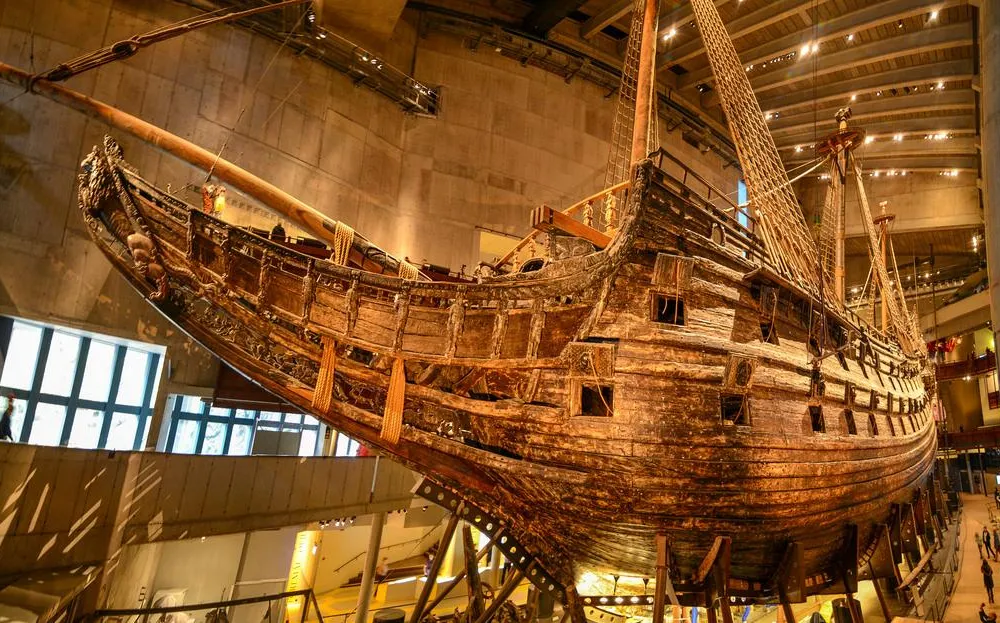The Bizarre Story of ‘Vasa,’ the Ship That Keeps On Giving
‘Vasa’ sunk in front of horrified onlookers on this day in 1628, claiming 30 lives

Vasa was the world’s most high-tech warship when it set sail. Today, it’s a resource for naval historians and archaeologists–and a cautionary tale for those who seek to design technology.
The story of what happened to the ship has gone down in history: despite being one of the Swedish navy’s biggest achievements and among “the most spectacular warships ever built,” according to Eric H. Kessler, Paul E. Bierly III and Shanthi Gopalakrishnan in The Academy of Management Executive, Vasa sank within twenty minutes of setting sail, on this day in 1628.
“The warship survived the first blast of wind it encountered on its maiden voyage in Stockholm Harbor,” writes Lucas Laursen for Archaeology. “But the second gust did it in. The sinking of Vasa took place nowhere near an enemy. In fact, it sank in full view of a horrified public, assembled to see off their navy’s–and Europe’s–most ambitious warship to date.” Engineering problems sank the ship–but this PR disaster for the Swedish navy has become a boon for archaeologists. Here’s how it happened and how Vasa‘s influence is felt today.
The sinking
Vasa was a vast, beautifully decorated ship. It was covered in wooden carvings that told stories about the Swedish royal family, and most importantly the king, Gustav II Adolf, writes Rhitu Chatterjee for Public Radio International. It was the king who ordered the ship, which carried an unprecedented 64 bronze cannons, to be built–and who watched in horror as it sunk.
“Soon after, there was an inquest that concluded that the ship had been unstable,” Chatterjee writes. “But the reasons behind the instability have remained a point of debate over the centuries.”
An archaeologist who has studied the remains of the ship in great detail thinks it sank because the gun deck was far too heavy–the result of its having been designed and built by someone with no experience building such a well-armed ship, Chatterjee writes. It didn’t help that the king rushed the building process.
The rediscovery
Although Vasa didn’t work out well for Gustav II Adolf, it’s become a boon for archaeologists. “The cold, oxygen-poor water of the Baltic Sea protected Vasa from the bacteria and worms that usually digest wooden wrecks,” writes Laursen. “Perhaps 95 percent of Vasa’s wood was intact when Sweden finally raised the wreck in 1961.”
Although keeping the wooden structures stable while raising the ship proved to be a huge engineering feat, it was managed. Preserving the ship was a process that took almost three decades, Laursen writes. During that time, there wasn’t much room for archaeology, but now that the ship is stable, investigators have worked to uncover why it sank. Beyond the simple engineering problems, writes Laursen, the “human question of why it was not” seaworthy is worth discussing.
The human factor
The management world has a name for human problems of communication and management that cause projects to founder and fail–Vasa syndrome. The events of August 10, 1628 had such a big impact that the sinking is a case study business experts still read about.
“An organization’s goals must be appropriately matched to its capabilities,” write Kessler, Bierly and Gopalakrishnan. In the case of the Vasa, “there was an overemphasis on the ship’s elegance and firepower and reduced importance on its seaworthiness and stability,” they write, “which are more critical issues.” Although it was originally designed to carry 36 guns, it was sent to sea with twice that number. At the same time, the beautiful ornamentation contributed to its heaviness and instability, they write. These and a host of other factors contributed to Vasa’s sinking and provide a cautionary tale for those designing and testing new technologies.
The remains of the ship can be found in Stockholm’s Vasa Museum. According to the museum, it is the only preserved 17th-century ship in the world, and the museum is a place for historical and anthropological study as well as for visitors from around the globe.
